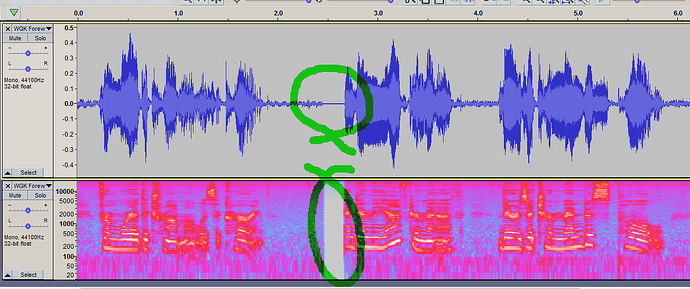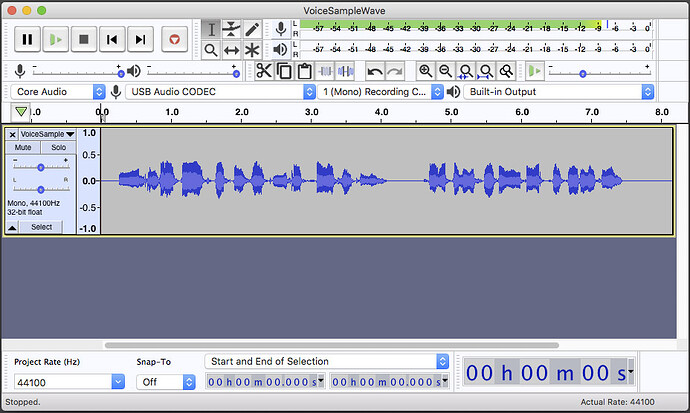Hi, I’m operating on a Windows 10 system, using version 3.0.2, and keep running into the above message on ACX Check.
I tried the suggestions on another thread about this, but am still running into problems.
I’m trying to attach a small sample, but I keep getting a message that my sample is too large (It’s five seconds of audio).
Could someone help me, please?
Thank you.
I found a way to attach the sample! ![]()
…and that should be “inf db…” – sorry for the typo ![]()
The original recording won’t have “dead digital silence”. Do you have the un-processed original? Either you artificially added silence or you were overly aggressive with a noise gate.
ACX Check was designed to work more or less the same way that the ACX Audiobook Acceptance testing works, and using their published production standards. We also folded in some of the experiences on the forum. We have had people fail acceptance because the noise was “too good.”
Agreed, -inf dB , is quieter than -60dB, the published quiet standard, but it’s not that easy to get to -inf dB volume on a production without damaging the show.
ACX Check looks for the quietest noise value in the sample and assumes that’s the way the show content was mixed. If you recorded in a nice quiet, echo-free room using a well behaved microphone, you may produce voice track noise at about -64dB or so. Gentle Noise Reduction can give you -70dB noise and you’re done. Go make coffee. Assuming everything else is OK, that should sail straight through ACX Acceptance.
If you start messing around with super Noise Reduction, Noise Gate, or inserting Audacity Generate Silence in the show, there’s a terrific chance you’re going to cause distortion and sound damage. That’s why measurements like that ring alarm bells.
So which one did you do? Where did the -inf dB background sound come from?
We should also note that it’s possible to get a home microphone to make sound files like that with automatic tools and corrections. That will almost always fail Human Quality Control at ACX. Nobody is going to buy your book if it sounds like a bad cellphone.
Koz
Another noise note. If you need to insert “silence” or gaps in the production, Do Not use Generate Silence. Instead, make up a chunk of existing Room Tone or noise and edit that in. There is a relatively new set of tools called Punch to make it easy.
https://manual.audacityteam.org/man/tutorial_punch_in_repair_of_recordings.html
Also:
https://manual.audacityteam.org/man/punch_and_roll_record.html
And here.
https://forum.audacityteam.org/t/punch-copy-paste/28906/1
Koz
Thank you so much, Koz and DVDoug.
I actually didn’t insert anything at all, and I’m not sure what it means to be “overly aggressive with the noise gate.”
I am a complete newbie to all of this, so a lot of what I’m reading from you both is out of my range of understanding.
I simply recorded, using a new track each time I made a mistake (I read that this is called “punch and roll”), and I used settings that were recommended on a web page that was linked to on acx.com.
Having said all that, I am uploading a sample of unprocessed recording here, to give you an idea.
I’ve since discovered that if I record one single track, by stopping, deleting the mistake, and re-recording in the same track, I don’t get the “inf db warning…” message. That seems to only happen when I record using multiple tracks.
So I’m now recording each chapter as one long track, and stopping to delete mistakes and re-recording as I go along. The most recent recording I did had a noise floor of -73.36 dB; RMS level -40.24 dB; and peak level at -14.39 dB. I’ve attached it, here.
It’s easier to see if there is any “-infinity dB”, (a/k/a absolute-silence), if you use Audacity’s spectrogram display …
Before we get too Techie-Crazy, you are planning on publishing with Audible/ACX, right?
They have two relatively new restrictions which can cause problems for New Readers.
– I have to be able to buy your book right now on Amazon in either paper or eBook.
– Your book has to not be on the Forbidden List (scroll down).
https://www.acx.com/help/200878270
There were two forum posters of note. One wanted to read her cookbook and other produced Yoga Chants. No word on how they came out, but we usually get cheers when people succeed. No cheers.
ACX made it silly-painful to do acceptance testing. They have on-line Audio Labs which will basically test the same things that ACX-Check does here. What they don’t do any more is short test posting and Human Quality Control. In short, they make you read and submit the whole book before you find out your voice is awful.
Tongue-ticking and mouth noises are what killed my audiobook career. I submitted a short test when they still had people who listened to the work and told me not to give up the day job.
But we can do analysis here on the forum.
Read and submit from this page. It’s ten seconds, but it’s harder than you think.
https://www.kozco.com/tech/audacity/TestClip/Record_A_Clip.html
Have you published before from a real sound studio? There are several forum posters who did that and wanted to see if they could make it work from home. It’s harder than you think.
Koz
Thank you, Trebor and Koz, for your responses. Yes, my books are all available for purchase on Amazon as both paperbacks and ebooks, they are not on the forbidden list, and I do want to publish on Audible. I had actors do my previous audio books, but I wanted to record the voice for this one myself. If it’s possible to record my own voice and then have someone else clean it up or master it, I would consider that option, too.
The only recording I’ve done of my own voice, in my own studio, has been for podcasts.
Eagerly awaiting that short sound test. No filters, effects, or corrections. Just read it, cut it to length and post it. We can tell more in ten seconds than any other sophisticated analysis or inspection. Some posters want us to “bring them home” and submit an already corrected work that’s not quite there. It’s almost 100% certain we will need to undo some of the poster’s corrections—and some of them don’t come out.
clean it up
That’s a forum buzz word. “Help Me Clean Up” is forum speak for “Make this steaming trash into a show.”
You seem to have most of this already licked.
The blue waves should peak about half-way during a reading like this.
You can get a bit quieter without too much chance of danger, but getting much louder can get you into trouble with overload. That’s when the system stops following the show and starts making up its own sound. It’s not pretty.
Too quiet can get you into trouble with background noise and you already have enough of that.
Koz
LOL ![]()
Okay, here’s the 10-second clip…
Trying again with the attachment. It looks like it didn’t go through with the message…
Got it. You may have been right on the edge of being a Responsible Adult and not need upload supervision. You need to be supervised when you’re new to keep you from trying to sell us kitchen cabinets, “Enhancement Products,” or “Grown-Up Entertainment.”
That rain-in-the-trees background noise (shshshsh) in the first two seconds is really loud. If I just master the clip for volume, the presentation won’t pass noise at all. I did force it to pass, but I had to use pretty stiff Noise Reduction to do it, and it’s just OK, not good.

So what’s the microphone and how are you getting it into the computer? It doesn’t sound like outside interference or motor noises. It just sounds like electronic noise from a tired microphone. “Spring rain in the trees” if you live in a part of the world with trees…or spring.
Koz
This might be handy. These are the Decibel (dB) relationships. Zero is maximum and they get quiet from there.
https://forum.audacityteam.org/t/audiobook-mastering-version-4/45908/68
Koz
Yes, I know. You went from producing surgically pure silence in your presentation to a clip that sounds like a hailstorm. That’s why we take these diagnostics one at a time.
Koz
There is an Audiobook Mastering Suite of (3) tools that when applied to your reading, guarantee ACX Peak and RMS (Loudness), and if you read well in a quiet, echo-free room, can produce an ACX compliant sound file. No, I don’t believe that, either. Home recording artists never pass noise. So you’re in good company.
Noise is the college course. Give us an idea what your microphone is and we can offer suggestions.
Home USB microphones almost always come out of the box at low volume. That’s Marketing. If a microphone is too loud, it can produce distortion and overload damage and make you want to send it back. Quiet microphones sound mostly OK and make you think it’s your fault…and keep the microphone. No contest.
That and nobody can read directly into ACX compliance. There’s always some processing in the middle to make a reading pass. So it’s a juggling act.
It’s unlikely you’re going to set up your microphone on the kitchen table, crank out successful audiobooks, and retire to Arizona. That’s Promotion and Publicity speaking, although given the drought, maybe Arizona wouldn’t be the best choice.
Koz
Koz wrote:
…trying to sell us kitchen cabinets, “Enhancement Products,” or “Grown-Up Entertainment.”
Perhaps they are “Sound Enhancement Products” ![]()
… about as useful as the nonsense Windows ships with sound drivers. ![]()
Wow, this all seems somewhat daunting and maybe impossible. I have a Blue Snowball and a Blue Yeti in terms of microphones. The 10-second sample was using the Snowball. I will try with the Yeti and hope for less noise, but if you’re saying all home studio mics are not going to cut, it then I need to start exploring other options.


